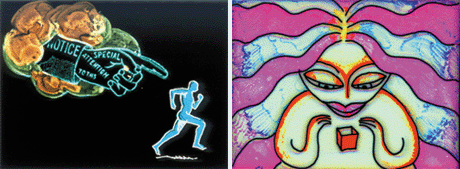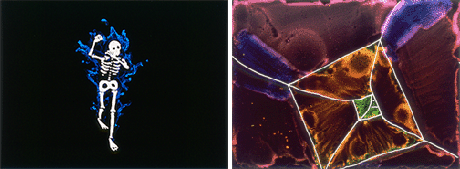Joan Kim interviews Nina Paley, Miche Cournoyer, Stephen X. Arthur, Kirsten Winter, Mikk Rand and Richard Reeves about their filmmaking techniques and learns that there is more than one way to make a picture move frame by frame.
This article contains QuickTime movie clips. If you don't have QuickTime get it now!
Innovate! Take a chance. Take a risk. Do something just to see what it looks like. Nina Paley, Michèle Cournoyer, Stephen X. Arthur, Kirsten Winter, Mikk Rand and Richard Reeves have done all of the above. Take a look at the descriptions from the artists themselves on the variety of materials and technical methods they incorporate into achieving the look and feel that they want. From traditional to more unorthodox techniques, these artists give us some insight into their creative process.
Nina Paley, Director/Animator
Nina Paley is probably best known for her alternative comic strip, Nina's Adventures, which began in 1988. She went on to create her film Pandorama, which was presented in IMAX theatres. Working as the producer for this project she was able to raise donations in the form of film stock, processing and services, and got Xlargo in Paris, France as a large-format distributor.
"I've used clay models; clay on glass on an Oxberry animation stand; 2D digital animation; drawing, scratching, painting and rubber-stamping directly on film; and drawing on paper with an animation table. Over the past 4 years I've used Super-8, 16mm, 35mm and 70mm film. I've used Flash, normally a Web animation program, for my film Fetch! I designed the movie at 24fps, and had the whole thing rendered to 35mm film on Monaco Labs' film recorder. I used a crude 'mini-rotoscope' system for parts of Pandorama and Cancer. I passed bits of 35mm slug with images I liked (usually people dancing) through a little backlit rig with brads as registration pins. Over this I layered clear leader. One frame at a time, I traced a few lines of movement with black Rapidograph. Later I added color to the other side of the film. "I love trying new techniques. I'm strictly limited by budget constraints, which is a drag, but it also drives me to find creative production methods. If I had to make my films the 'correct' way, they'd never get done!"


Michèle Cournoyer, Le Chapeau's director. Le Chapeau has stunned audiences the world over. Producers: Thérèse Descary, Pierre Hébert. © NFB.
Michèle Cournoyer, Director/Animator
"I was using an electronic pen and a painter program on a Macintosh computer to paint images for The Hat/Le Chapeau. My producer and I found that these virtual images were too aesthetic. We realized that a film on such a visceral topic as incest needed a primitive approach. Steering clear of technical complexities gave me a more intimate relationship with the characters I was depicting.
"With my experience as a painter, I decided to go back to using India ink on paper, with an effect similar to Japanese brush paintings. The stark black lines on white evoke the nakedness of the dancer and the broken child inside her. Like the man who violated her innocent childhood, I attacked the white paper with urgent strokes, mistreating the brushes, splashing stains on the paper, stains on her soul.
"I worked without a storyboard, ignoring the rules of classical animation, without compromise or censure, in direct communication with my demons and angels."

 Transfigured. © National Film Board of Canada. View a clip! Vision Point. © Stephen X. Arthur. View a clip!
Transfigured. © National Film Board of Canada. View a clip! Vision Point. © Stephen X. Arthur. View a clip!
Stephen X. Arthur, Director
Stephen X. Arthur is an experimental animation director. While one of his specialties is working in digital photo-based hybrid media, after reading the below points you will see that he is combining many techniques and methods in his films, which are showcased here on AWN. A Vancouver-based commercial production house also represents Stephen.
(1) In The Recess, facial emotions were animated with the digital 2D warping of photographs. Faces also appear to turn sideways in pseudo-3D.
(2) In Transfigured, a causal chain of matching actions lets us enter a seamless world constructed of oil paintings from a retrospective of an artist's 50 years of work. Events were choreographed in movement phrases with synchronized sounds to help follow the transformations. Digital animation of scanned images was recorded to 35mm by plunking the monitor under an Oxberry animation camera.
(3) For Vision Point, camera and environment were animated together as "point-of-view animation" or "landscape pixilation" of still photographs in Adobe After Effects. A combination of travelling "time-lapse" shots, extreme telephoto cropping and stabilization on a background point creates a surprising separation of foreground and background and makes the landscape dance.
(4) A neural network trained on sequential image pairs was set free to create its own animation by feeding each output frame back as input. Experiments show promise for generating "prototypical" imagery from existing material.
(5) Straight-ahead hand-painted digital animation, seeing only the last frame, not thinking ahead, doodling directly into the computer -- this yielded spontaneous, organic animation with the feeling of closed-eye visions and hypnagogic reveries.
(6) I am currently combining techniques (staged in 3ds max) as a faux commercial spot to demonstrate applied art.

 Smash. © Kirsten Winter. View a clip! Just in Time. © Kirsten Winter. View a clip!
Smash. © Kirsten Winter. View a clip! Just in Time. © Kirsten Winter. View a clip!
Kirsten Winter, Director/Animator
"Clocks combines portraits of Elena Kats-Chernin through long time exposure photos of a TV-Monitor (High-8 shots taken of Elena in different situations and of different surroundings), then a cel was placed on to the photo prints. The cels were then painted on top with oil-colours. After three frames the photo print was changed, but the painted cel remained consistent, frame by frame. So, the movement is very fluent and scenes that I didn't shoot on High-8 could be easily added by painting (like links in-between scenes). The photos that look out of focus and softened fit perfectly with the painting, so you often can't tell what is photography and what is oil painting.
"Smash depictslife before and after an accident. Footage was taken using VHS-Video, High-8 and DV, then it was put onto a computer using Adobe Premiere to achieve a consistent look. Cels were placed on the computer monitor and painted frame by frame with oil colours on the cel, the 'Premiere treated' PICT image underneath. Then shot frame by frame with my 35mm animation camera. I combined this footage with oil-painted landscapes.
"Just in Time captures travel by train all over the U.S.A. The DV footage was then treated with Adobe After Effects to create effects like 'breathing' bridges and special transitions where I worked with travelling mattes a lot. Then it was combined with scratched footage and BI-PACK shots. To eliminate the video-look it took several generations with my small and slow G3 Mac -- so I had to compress the footage a few times. The quality of each single frame was 'kind of disgusting.' And it became more obvious when I combined it with scratched footage that had a sharper, more in focus look. So I used a very strong red colour as a link and my style of editing helped a lot. I created a film that doesn't look like it was blown up from DV, but had all the advantages of creating effects that a computer offers. When you screen it on a large screen with the ratio 1:1.85, the film looks very grainy, and no one believed that it was shot on video. I created the grainy look without effects (I had 'tons' of effects but no 'rain' or 'film-look' effect). The grainy look was just a result of compressing the footage several times and using a combination of other effects.
"Escape has just been completed and will be screened in competition at the WFF Montreal in August/September. Escape was mainly done with 3D animation that I created without the use of a computer!"

 The Mosquito and The Horse from Mikk Rand of Estonia. © 2001 Mikk Rand/Multi Film Ltd.
The Mosquito and The Horse from Mikk Rand of Estonia. © 2001 Mikk Rand/Multi Film Ltd.

replace_caption_kimtech13.gif
Mikk Rand, Animator/Director/Producer (Never Artist)
"I don't know if there is anything very unusual about what we use in generating our animation or not. We use whatever materials there are. All the materials that man can use are what we use. If it fits with our idea and imagination of what we like and want to see in our filmmaking it works: photos, puppets, drawings, stills, scanning cloth, metal and timber. Integrating them and filming them together just to get the same sense of a moving picture that was in the idea that we had in the beginning. Even using live-action works exceptionally well. I have used hand-held cameras shooting frame by frame, turning the camera's motor ahead, understanding that it will give a very rambling picture illustrating the neurotic feeling that I want to produce. I have animated the snow, sand and soil -- you might call it earth painting in the visual sense. And always assisting us is computer animation software. We use several different programs to compose and mix the different techniques. Because mixing is everything! A variety of techniques can be used, as long as I can get exactly and precisely the emotion that I think this technique will produce for the audience during the screening of the film. So, there really are no special or unusual techniques other than just having some material and being technically eclectic at a high level to maintain continuity."
Richard Reeves, Director/Scratch Animation Instructor
"All of my animation films are produced without the use of a camera. Images are created by drawing, painting and scratching directly onto raw motion picture film stock. To compliment these visuals, music and sounds are also scratched or applied directly on to the audio stripe of the optical sound area along the edge of the film. Some of the visuals are created using tools such as an airbrush with coloured inks or magic markers. Also, sandpaper, steel-wool and exacto blades are used for etching into the emulsion, along with bleach to act as a developer and a cork with a pin stuck into it which creates fine dots of light when hammered into the emulsion.

Richard Reeves' Linear Dreams. © Richard Reeves. View a clip!
"As many as four different types of film stock are used and mixed, each with a different aesthetic value. These are....
Clear film: for the application of inks Black film: for etching into; this turns clear then colours may be added Colour opaque film: similar to black film only upon scratching lightly the scratches turn green, with a little more pressure it turns yellow, and if etched directly through becomes clear Orange mask film: to create a handmade negative, it requires being printed at the lab to become a positive and the colours are then reversed.
"To compliment the persistence of vision, I like to add some echo effects to the handmade soundtracks, as this becomes a persistence of sound.
"As no camera or musical instruments are used, the projector itself becomes the musical instrument and picture generator for which the sounds have been composed."
Joan Kim received her B.A. in English Literature from UCLA and is currently freelancing in Los Angeles completing writing and graphics related projects. Previously as a graphics consultant she produced several company reports and manuals and continues to pursue an education in computer graphics.









